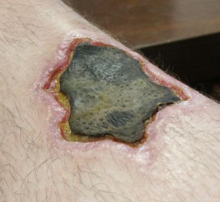醫學上「細胞死亡」的兩種情況:「壞死」(Necrosis)「凋亡」(Apoptosis)。「壞死」的情況是像以鐵鎚敲自己的手敲爛,而「凋亡」則是像蝌蚪成為青蛙時尾巴的自動消失。所以「凋亡」是一種有計畫的死亡(消失),和「壞死」大不相同。此外,「凋亡」組織的細胞,細胞膜是萎縮而非像「壞死」那樣,細胞受損而破裂,也因此不會有內含物漏出的情況,引起發炎反應。
Necrosis (from the Greek νέκρωσις "death, the stage of dying, the act of killing" from νεκρός "dead") is a form of cell injury which results in the premature death of cells in living tissue by autolysis.[1]
Necrosis is caused by factors external to the cell or tissue, such as infection, toxins, or trauma which result in the unregulated digestion of cell components.
In contrast, apoptosis is a naturally occurring programmed and targeted cause of cellular death.
While apoptosis often provides beneficial effects to the organism, necrosis is almost always detrimental and can be fatal.[2]
Cellular death due to necrosis does not follow the apoptotic signal transduction pathway, but rather various receptors are activated, and result in the loss of cell membrane integrity and an uncontrolled release of products of cell death into the extracellular space.[1]
This initiates in the surrounding tissue an inflammatory response which attracts leukocytes and nearby phagocytes which eliminate the dead cells by phagocytosis. However, microbial damaging substances released by leukocytes would create collateral damage to surrounding tissues.[3] This excess collateral damage inhibits the healing process. Thus, untreated necrosis results in a build-up of decomposing dead tissue and cell debris at or near the site of the cell death. A classic example is gangrene. For this reason, it is often necessary to remove necrotic tissue surgically, a procedure known as debridement.
Contents


沒有留言:
張貼留言